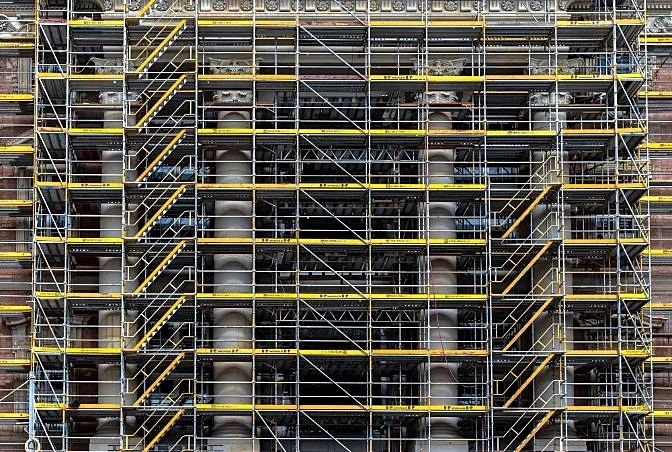Checking Out the Different Sorts Of Scaffolding Utilized in Building Tasks
The building and construction industry relies heavily on numerous sorts of scaffolding to fulfill certain project demands, each offering distinct benefits and applications. Typical frame scaffolding gives a tough structure for basic tasks, while suspended scaffolding is crucial for work with skyscraper frameworks. Various other choices, such as system and rolling scaffolding, deal with efficiency and flexibility, respectively. The cantilever alternative shows important in metropolitan atmospheres where area is constrained. Comprehending the subtleties of these scaffolding kinds is crucial for enhancing security and efficiency on building and construction websites, triggering a closer assessment of their special attributes and applications.

Standard Framework Scaffolding
Traditional structure scaffolding is one of one of the most extensively utilized approaches in the building and construction industry because of its effectiveness and versatility. This system contains upright and horizontal structures that are constructed to produce a stable platform for products and employees. The primary parts include vertical articles, horizontal journals, and diagonal dental braces, which with each other offer a solid structure that can support substantial lots.
Among the essential benefits of standard structure scaffolding is its versatility to various construction jobs, varying from residential buildings to big commercial frameworks. The modular design enables very easy assembly and disassembly, making it effective for both short-term and long-lasting jobs. In addition, the system can be tailored in height and size, suiting various structure layouts and website conditions.
Safety is critical in scaffolding applications, and traditional structure systems are furnished with guardrails and toe boards to stop drops and make sure employee protection. Normal assessments and adherence to safety and security guidelines are critical in maintaining the honesty of the scaffold (Scaffolding). Overall, standard frame scaffolding remains an essential option in the building and construction sector, offering a dependable system for labor and enhancing overall task effectiveness

Suspended Scaffolding
Put on hold scaffolding provides a distinct remedy for building tasks that require accessibility to elevated surface areas, especially in circumstances where conventional structure scaffolding may be not practical. This kind of scaffolding is typically suspended from the roof or top degrees of a structure, using a system of sheaves, ropes, and systems to create a working room that can be gotten used to different heights.
One of the key benefits of suspended scaffolding is its adaptability. It can be quickly repositioned or decreased to suit changes in building needs, making it perfect for tasks such as window installation, façade work, and upkeep on high-rise buildings. Additionally, the minimal footprint of suspended scaffolding enables much better use ground area in city environments, where room is commonly restricted.
Safety and security is an essential factor to consider in using put on hold scaffolding. Correct rigging and anchoring systems must be utilized to guarantee stability and stop accidents. Operators should additionally be learnt the safe use this devices. In general, suspended scaffolding provides a effective and efficient solution for accessing hard-to-reach locations in different building situations, enhancing both performance and safety and security on website.
System Scaffolding
System scaffolding, frequently considered as a modern service in the scaffolding market, is composed of pre-engineered components that can be quickly put together and adapted for numerous building and construction jobs. Scaffolding. This kind of scaffolding is identified by its modular design, which enables adaptability and effectiveness on work websites, suiting architectural demands and different heights
Commonly made from high-strength steel or aluminum, system scaffolding provides boosted durability and security. The parts consist of vertical posts, horizontal journals, and angled dental braces, which adjoin firmly, making certain a robust framework. The layout typically includes try here standardized fittings, simplifying setting up and disassembly procedures, consequently reducing labor time and prices.

Rolling Scaffolding
Rolling scaffolding scaffold services inc is a flexible option to conventional fixed scaffolding, created for wheelchair and simplicity of usage on building websites. This kind of scaffolding includes a system supported by frameworks with wheels, allowing workers to conveniently transfer it as required. The movement attribute considerably improves efficiency, as it reduces downtime connected with disassembling and setting up taken care of scaffolding.
Commonly created from light-weight materials such as aluminum or steel, rolling scaffolding uses a tough yet portable service for projects requiring frequent repositioning - Scaffolding. It is especially beneficial in tasks such as painting, drywall installation, and electric job, where accessibility to various elevations and locations is required
Security is critical in rolling scaffolding style, with functions such as securing wheels to stop unexpected activity when in operation, and guardrails to shield workers from drops. Furthermore, many designs are adjustable in height, fitting various task needs.
Cantilever Scaffolding

The layout of cantilever scaffolding generally involves making use of brackets or arms secured to a structure or structure, allowing the platform to prolong external securely. Safety is extremely important; hence, these scaffolds need to be crafted to stand up to ecological conditions and various lots. Normal examination and maintenance are necessary to guarantee architectural stability and employee security.
Cantilever scaffolding is preferred for its versatility and reliable use of room, making it a prominent option in urban atmospheres where area restraints are common. It promotes much easier accessibility to high altitudes, eventually contributing to the total efficiency of building and construction projects. As with all scaffolding types, appropriate training and adherence to security requirements are essential for employees making use of cantilever scaffolding.
Conclusion
Traditional frame scaffolding supplies stability, while put on hold scaffolding offers convenience for elevated tasks. System scaffolding promotes quick setting up, and rolling scaffolding boosts wheelchair for varying job atmospheres.
Typical structure scaffolding supplies a durable structure for basic tasks, while suspended scaffolding is important for work on high-rise structures.Moving scaffolding is a functional option to traditional fixed scaffolding, made for mobility and convenience of use on building and construction sites. As with all scaffolding kinds, appropriate training and adherence to safety and security requirements are critical for workers making use of cantilever scaffolding.
Conventional structure scaffolding gives stability, while suspended scaffolding offers adaptability for elevated tasks. System scaffolding assists in quick assembly, and rolling scaffolding improves movement for varying job atmospheres.